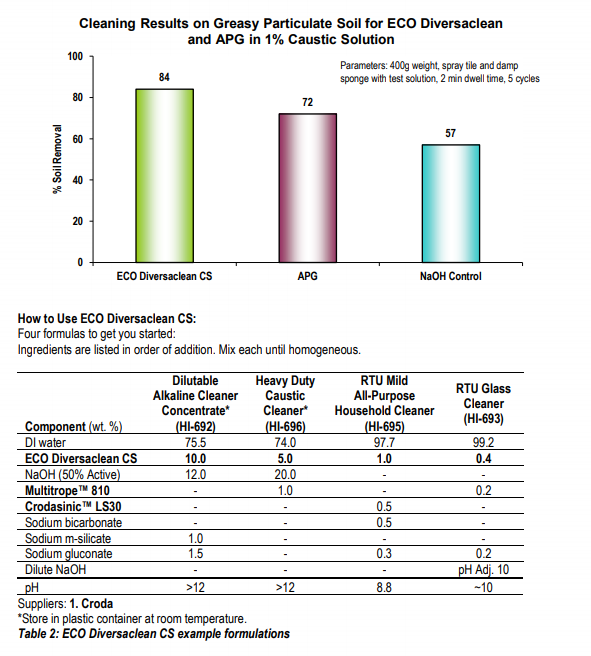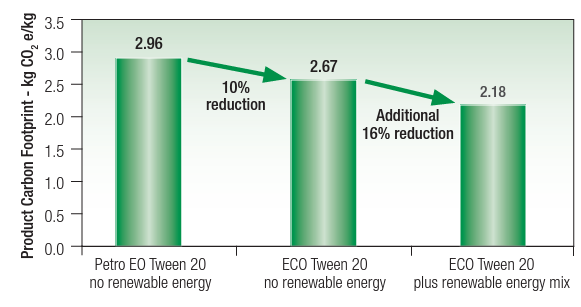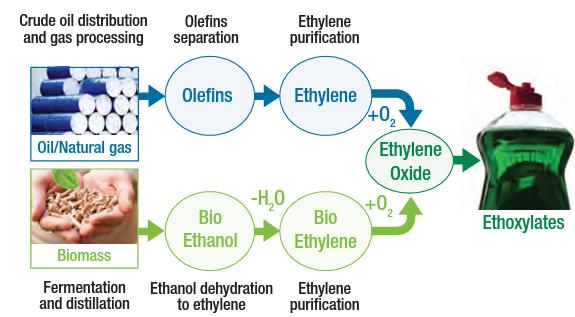Knowde Enhanced TDS
Identification & Functionality
- Cleaning Ingredients Functions
- Technologies
Features & Benefits
- Labeling Claims
- HII Features
- Versatile surfactant blend for highly alkaline formulations
ECO Diversaclean CS is a specially designed surfactant blend suitable for highly alkaline household and industrial & institutional (I&I) cleaning applications. ECO Diversaclean CS is part of Croda’s 100% renewable, 100% bio-based ECO Range of surfactants. ECO Diversaclean CS is caustic stable and designed to deliver the excellent cleaning and wetting performance of non-ionic alcohol ethoxylates combined with the alkaline stability and green profile of sugar-based alkyl polyglucosides (APG’s).
Features and Benefits of the ECO Diversaclean CS
- 100% Renewable
- 100% Bio-based*
- Reduces reliance on fossil fuel feedstocks
- Stable in high caustic formulations
- Manufactured with renewable energy
- Lower carbon footprint than petroleum based analogs
- Certified for bio-based content by the USDA BioPreferred® Program
*Calculated using USDA BioPreferred Method for determining bio-based content which is to be validated by carbon 14 testing (ASTM D6866)
USDA BioPreferred is a registered trademark of the U.S Department of Agriculture- High Compatibility in Caustic Solutions
ECO Diversaclean CS will generate clear, compatible aqueous solutions with up to 14% NaOH (active) and >2% surfactant. If more concentrated levels of caustic are required, ECO Diversaclean CS can be blended with additional alkyl polyglucoside (NatraSense™ AG-810) at a ratio of 5:3 (CS/APG) to yield clear formulations with up to 30% NaOH (active). ECO Diversaclean CS blends with APG maintain a cleaning and wetting benefit over APG alone.
- Benefits & Applications
- Excellent stability in highly alkaline formulations
- Easy to formulate as concentrated or ready-to-use products
- Powerful wetting and cleaning against household and I&I soils
- 100% bio-based content
- Readily biodegradable
- Low streaking, excellent for glass cleaners
- Low surface tension, high foaming
- ECO Range
ECO Diversaclean CS is manufactured using ethylene oxide derived from bio-ethanol, resulting in 100% renewable surfactants with performance identical to petroleum-based options. This 100% bio-based product eliminates the need to choose between high performance and fully renewable ingredients. By using an alternative route to ethylene oxide with bioethanol from biomass sources, it significantly increases the bio-based content of ethoxylated products and reduces reliance on fossil fuels. Additionally, ECO Diversaclean CS is manufactured with high levels of renewable energy. Sustainability informs and guides our development strategies and is an integral part of our business. ECO Diversaclean CS addresses the consumer demand for more sustainable products and aids our customers in meeting their own sustainability goals, while delivering a high performance product to the market.
- Certified Sustainable Palm Oil Derivatives – Mass Balance
ECO NatraSense™ series is Croda’s sustainable palm oil variant allowing customers to use sustainably sourced material if they wish. The products are manufactured by the RSPO’s Mass Balance system. The Mass Balance supply chain allows certified sustainable palm oil material and non-certified material to be mixed throughout the supply chain but administratively monitors the mass of certified material produced and sold. The Mass Balance system is fully audited allowing buyers of the material to view the products life span. Another advantage of this system is that it actively encourages palm growers to produce sustainable palm and move towards a segregated supply chain system. By choosing these ingredients, you contribute to the production of sustainable palm oil. Products manufactured with sustainable palm oil do not in any way compromise on performance.

Figure 2: RSPO Mass Balance Supply Chain
- 100% Bio-based ECO Range
Sustainability is in our DNA. It is integral to everything we do. From the raw materials we source and the way we use them, to the ingredients we create, we believe in being a responsible company. We are pleased to introduce our new ECO range of 100% bio-based surfactants. Over 50 products make up the ECO range made by using bio-based ethylene oxide (EO) which we manufacture from biomass ethanol. Coupling the use of bio-based EO with the high proportion of renewable energy used at the manufacturing plant, leads to a significant reduction in carbon footprint for the ECO product range. Formulators can now access 100% renewable surfactants without sacrificing performance to help meet increasingly demanding sustainability targets.
The new range of ECO surfactants
- 100% renewable
- Performance identical to petrochemicalbased options
- Lower carbon footprint than petrochemically derived ingredients
- USDA BioPreferred®Program third party certification
- RSPO Supply Chain Certified via Mass Balance
- Made using renewable energy
- ECO Range Multi-layered Renewable Benefits
The ECO range provides multi-layered renewable benefits and value for our customers. Not only will formulators be able to replace petrochemical-based non-ionic analogs while experiencing “zero sacrifice” in performance, they will be able to replace less-effective “natural” market alternatives as well.
Bio-based & Sustainable
- Sustainable palm sourcing, RSPO supply chain certified via Mass Balance†
- Biomass raw material for 100% bio-based ethylene oxide and derivatives
Low Carbon Footprint
- Made using energy sourced from landfill gas and solar energy
- Cradle-to-gate carbon footprint
ECO Range
- 100% bio-based surfactants
Community Benefit
- 30 new full time employees
- Reduced rail freight miles of highly flammable petrochemical EO from the Gulf of Mexico
Green Labeling
- EPA Safer Choice recognized for biodegradability and low toxicity
- USDA BioPreferred® third party certification of C14 measurements
Applications & Uses
- Markets
- Applications
- Home Care Applications
- I&I Cleaning Applications
- How to Use ECO Diversaclean CS
Four formulas to get you started:
Ingredients are listed in order of addition. Mix each until homogeneous.Component (wt. %) Dilutable Alkaline Cleaner Concentrate* (HI-692) Heavy Duty Caustic Cleaner*
(HI-696)RTU Mild
All-Purpose Household Cleaner
(HI-695)RTU Glass Cleaner
(HI-693)DI water 75.5 74.0 97.7 99.2 ECO Diversaclean CS 10.0 5.0 1.0 0.4 NaOH (50% Active) 12.0 20.0 - - Multitrope™ 810 - 1.0 - 0.2 Crodasinic™ LS30 - - 0.5 - Sodium bicarbonate - - 0.5 - Sodium m-silicate 1.0 - - - Sodium gluconate 1.5 - 0.3 0.2 Dilute NaOH - - - pH Adj. 10 pH >12 >12 8.8 ~10 Suppliers: 1. Croda
* Store in plastic container at room temperature.
Table 2: ECO Diversaclean CS example formulations
Properties
- Physical Form
Regulatory & Compliance
Technical Details & Test Data
- Performance Testing
Formulations containing 1% caustic (as NaOH) were prepared by blending with either 1% ECO Diversaclean CS or 1% APG and compared to caustic solution alone. The formulations were compared for cleaning efficacy using a Sheen scrub test with a greasy particulate soil on ceramic tiles. As shown below in the chart, the highest soil removal was found using the ECO Diversaclean CS compared to APG or caustic alone. The ECO Diversaclean CS gave a clear boost in cleaning performance over the APG.

- Improved Bio-based Content
Chemically equivalent to petrochemical-based ethoxylates, Table 1 shows the improvement in bio-based content for key surfactant chemistries when produced using our bio-based EO.
Surfactant Bio-based content
with synthetic EO (%)Bio-based content
with Bio-EO (%)Laureth-6 50 100 Laureth-7 46 100 PEG-40 castor oil 42 100 Polysorbate 20 31 100 Trideceth-9 0 58 C9-C11 + 6EO 0 55 Table 1: Comparison of percentage bio-based content between using petrochemical based EO versus bio-based EO*.
* Calculated using ASTM D6866 which is validated by carbon 14 testing.
† RSPO Grades - Certified sustainable palm oil grades by mass balance (minimum)- Avoidance of Greenhouse Gas (GHG) Emissions
Converting landfill gas to electricity and steam avoids the release of methane into the atmosphere, which has a global warming potential 25 times greater than CO2 when measured over 100 years. Our use of landfill gas since 2012, combined with the reduction in our usage of natural gas, has led to an aggregate reduction in GHG emissions of close to 1 million tons CO2e. Annually, the amount of avoided emissions is a figure equivalent to our total combined Group 1 and 2 emissions.
- Carbon Footprint of ECO Range
We have used SimaPro software to model the cradle-to-gate life cycle analysis (LCA) of our ECO product families, focused on the climate change impact category, following the technical specification ISO 14067. The high proportion of renewable energy available at Atlas Point, along with the use of bio-based EO, leads to a significant reduction in carbon footprint for a typical ECO product family, when compared to traditional ethoxylates made using petrochemical-based EO and without renewable energy (Figure.4)

Figure 4: Carbon footprint example for Tween 20. Demonstrates the unique carbon footprint reduction moving from petrochemical-based EO to bio-based EO, plus the
plant's use of renewable energy for these ingredients.Δ Atlas Point renewable energy calculated for the 2018 sustainability report.
ΔΔ Group 1 emissions are direct emissions. Group 2 emissions are indirect emissions from the generation of purchased power- Making Ethylene Oxide Sustainable
With increasing consumer demand for renewably sourced and sustainable products, we are pleased to introduce our new ECO range of 100% bio-based surfactants. In recent years, “greener” non-ethoxylated ingredients have been used in the pursuit of more renewable formulations, but the performance has not met the levels achieved when using traditional ethoxylates. With significant investment at our Atlas Point manufacturing site, located in Delaware, USA, our plant is the first of its kind in the US to produce bio-based EO from bio-ethanol (Figure 3). This development enables the production of sustainable and bio-based ethoxylates (Figure.1)

Figure 1: The petroleum and bio-based production pathways of ethylene oxide.
- Certified Bio-based Content
Our new ECO range helps formulators meet renewability targets. Table 2 lists the BioPreferred bio-based content requirement of a finished formulation under a product category. Replacing petrochemical based surfactants for ECO range products will improve bio-based content of the formulation. All ECO products are being registered on the USDA BioPreferred Program.
Product Category % Bio-based Bathroom Cleaner 74 Bathroom Cleaner 58 Laundry Product 34 Table 2: Examples of USDA BioPreferred product categories and associated minimum bio-based content to be eligible for certification.
- Renewable Energy at Atlas Point
In 2012, we invested in a renewable energy project at our Atlas Point manufacturing site located in Delaware, USA (Figure 3). This investment saw the installation of a 3.5 mile pipeline from a local landfill site so that we could purchase local landfill gas. The gas feeds two combined heat and power (CHP) units and a multi-fuel boiler to generate electricity and steam for the plant. In 2014, we further invested in solar panels at the site, which reduced our annual carbon dioxide (CO2) emissions by 11,600 tons CO2e. By quarter two of 2020, a third CHP unit will be installed, increasing our capacity for generating electricity and steam from landfill gas and increasing the estimated percentage of the site’s energy being renewably sourced to above 30%.
Packaging & Availability
- Country Availability
- Regional Availability